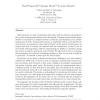33 search results - page 5 / 7 » Evolutionary motion design for humanoid robots |
RAS
2008
13 years 6 months ago
2008
Robot projects are often evolutionary dead ends, with the software and hardware they produce disappearing without trace afterwards. Common causes include dependencies on uncommon ...
ICRA
2003
IEEE
14 years 21 days ago
2003
IEEE
− In humanoid robot system, many human-body motions such as walking, running, jumping, etc require large power. To achieve a high power-to-weight ratio, this paper proposes a new...
NIPS
2008
13 years 8 months ago
2008
Motor primitives or motion templates have become an important concept for both modeling human motor control as well as generating robot behaviors using imitation learning. Recent ...
IROS
2009
IEEE
14 years 2 months ago
2009
IEEE
— This paper discusses the mechanical kinematics solutions and design aspects of the biped robot SHERPA, a bipedal platform able to walk and carry load. Starting from the analysi...
CEC
2010
IEEE
13 years 8 months ago
2010
IEEE
Embodying robot morphologies evolved in simulation can present serious problems for an engineer when translating simplified simulated mechanisms into working devices, often drawing...

